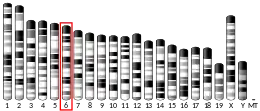ATG7
Autophagy related 7 is a protein in humans encoded by ATG7 gene.[5][6] Related to GSA7; APG7L; APG7-LIKE.[6]
ATG 7, present in both plant and animal genomes, acts as an essential protein for cell degradation and its recycling.[7][8] The sequence associates with the ubiquitin- proteasome system, UPS, required for the unique development of an autophagosomal membrane and fusion within cells.[9]
ATG7 was identified based on homology to yeast cells Pichia pastoris GSA7 and Saccharomyces cerevisiae APG7. The protein appears to be required for fusion of peroxisomal and vacuolar membranes.[10]
Autophagy is an important cellular process that helps in maintaining homeostasis. It goes through destroying and recycling the cytoplasmic organelles and macromolecules. During the initiation of autophagy, ATG7 acts like an E-1 enzyme for ubiquitin-like proteins (UBL) such as ATG12 and ATG8. ATG7 helps these UBL proteins in targeting their molecule by binding to them and activating their transfer to an E-2 enzyme. ATG7's role in both of these autophagy-specific UBL systems makes it an essential regulator of autophagosome assembly.[11]
Homologous to the ATP-binding and catalytic sites of E1 activator proteins, ATG7 uses its cysteine residue to create a thiol-ester bond with free Ubiquitin molecules.[9][12] Through UPS, Ubiquitin will continue to bind to other autophagy-related proteins, E2 conjugation proteins and E3 protein ligases, to attach Ubiquitins to a target substrate to induce autophagy.[13]
ATG 7 is often associated with ATG12/ ATG5 sequenced ubiquitination cascade. As well in presence of p53 cell cycle pathways during stressed and nutrient poor environments.[14][15]
References
- GRCh38: Ensembl release 89: ENSG00000197548 - Ensembl, May 2017
- GRCm38: Ensembl release 89: ENSMUSG00000030314 - Ensembl, May 2017
- "Human PubMed Reference:". National Center for Biotechnology Information, U.S. National Library of Medicine.
- "Mouse PubMed Reference:". National Center for Biotechnology Information, U.S. National Library of Medicine.
- Yuan W, Stromhaug PE, Dunn WA (May 1999). "Glucose-induced autophagy of peroxisomes in Pichia pastoris requires a unique E1-like protein". Molecular Biology of the Cell. 10 (5): 1353–66. doi:10.1091/mbc.10.5.1353. PMC 25277. PMID 10233149.
- "Entrez Gene: ATG7 ATG7 autophagy related 7 homolog (S. cerevisiae)".
- Online Mendelian Inheritance in Man (OMIM): AUTOPHAGY 7, S. CEREVISIAE, HOMOLOG OF; ATG7 - 608760
- "Mechanisms for autophagy: 2016 Nobel Prize in Physiology or Medicine". ScienceDaily. Retrieved 2017-10-20.
- Lilienbaum A (March 2013). "Relationship between the proteasomal system and autophagy". International Journal of Biochemistry and Molecular Biology. 4 (1): 1–26. PMC 3627065. PMID 23638318.
- Yuan W, Stromhaug PE, Dunn WA (May 1999). "Glucose-induced autophagy of peroxisomes in Pichia pastoris requires a unique E1-like protein". Molecular Biology of the Cell. 10 (5): 1353–66. doi:10.1091/mbc.10.5.1353. PMC 25277. PMID 10233149.
- Xiong J (October 2015). "Atg7 in development and disease: panacea or Pandora's Box?". Protein & Cell. 6 (10): 722–34. doi:10.1007/s13238-015-0195-8. PMC 4598325. PMID 26404030.
- Lecker SH, Goldberg AL, Mitch WE (July 2006). "Protein degradation by the ubiquitin-proteasome pathway in normal and disease states". Journal of the American Society of Nephrology. 17 (7): 1807–19. doi:10.1681/ASN.2006010083. PMID 16738015.
- Myung J, Kim KB, Crews CM (July 2001). "The ubiquitin-proteasome pathway and proteasome inhibitors". Medicinal Research Reviews. 21 (4): 245–73. doi:10.1002/med.1009.abs. PMC 2556558. PMID 11410931.
- Lee IH, Kawai Y, Fergusson MM, Rovira II, Bishop AJ, Motoyama N, Cao L, Finkel T (April 2012). "Atg7 modulates p53 activity to regulate cell cycle and survival during metabolic stress". Science. 336 (6078): 225–8. Bibcode:2012Sci...336..225L. doi:10.1126/science.1218395. PMC 4721513. PMID 22499945.
- Das S (February 2018). "Unraveling the CNOT: A new player in the autophagy-cell death nexus". Science Signaling. 11 (516): eaar6364. doi:10.1126/scisignal.aar6364. PMID 29438015. S2CID 3325931.
Further reading
- Tanida I, Tanida-Miyake E, Komatsu M, Ueno T, Kominami E (April 2002). "Human Apg3p/Aut1p homologue is an authentic E2 enzyme for multiple substrates, GATE-16, GABARAP, and MAP-LC3, and facilitates the conjugation of hApg12p to hApg5p". The Journal of Biological Chemistry. 277 (16): 13739–44. doi:10.1074/jbc.M200385200. PMID 11825910.
- Tanida I, Tanida-Miyake E, Nishitani T, Komatsu M, Yamazaki H, Ueno T, Kominami E (March 2002). "Murine Apg12p has a substrate preference for murine Apg7p over three Apg8p homologs". Biochemical and Biophysical Research Communications. 292 (1): 256–62. doi:10.1006/bbrc.2002.6645. PMID 11890701.
- Mizushima N, Yoshimori T, Ohsumi Y (December 2002). "Mouse Apg10 as an Apg12-conjugating enzyme: analysis by the conjugation-mediated yeast two-hybrid method". FEBS Letters. 532 (3): 450–4. doi:10.1016/S0014-5793(02)03739-0. PMID 12482611. S2CID 37247321.
- Nemoto T, Tanida I, Tanida-Miyake E, Minematsu-Ikeguchi N, Yokota M, Ohsumi M, Ueno T, Kominami E (October 2003). "The mouse APG10 homologue, an E2-like enzyme for Apg12p conjugation, facilitates MAP-LC3 modification". The Journal of Biological Chemistry. 278 (41): 39517–26. doi:10.1074/jbc.m300550200. PMID 12890687.
- Otsuki T, Ota T, Nishikawa T, Hayashi K, Suzuki Y, Yamamoto J, Wakamatsu A, Kimura K, Sakamoto K, Hatano N, Kawai Y, Ishii S, Saito K, Kojima S, Sugiyama T, Ono T, Okano K, Yoshikawa Y, Aotsuka S, Sasaki N, Hattori A, Okumura K, Nagai K, Sugano S, Isogai T (2007). "Signal sequence and keyword trap in silico for selection of full-length human cDNAs encoding secretion or membrane proteins from oligo-capped cDNA libraries". DNA Research. 12 (2): 117–26. doi:10.1093/dnares/12.2.117. PMID 16303743.
- Tanida I, Sou YS, Minematsu-Ikeguchi N, Ueno T, Kominami E (June 2006). "Atg8L/Apg8L is the fourth mammalian modifier of mammalian Atg8 conjugation mediated by human Atg4B, Atg7 and Atg3". The FEBS Journal. 273 (11): 2553–62. doi:10.1111/j.1742-4658.2006.05260.x. PMID 16704426. S2CID 11899126.
External links
- Human ATG7 genome location and ATG7 gene details page in the UCSC Genome Browser.




